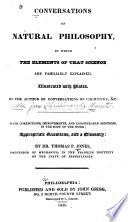 The variation, therefore, in the distances of the sun and moon from the centre of the earth, and of the moon from her node at the instant of conjunction, occasions great varieties in the solar eclipses. Besides, the height of the moon above the horizon... The variation, therefore, in the distances of the sun and moon from the centre of the earth, and of the moon from her node at the instant of conjunction, occasions great varieties in the solar eclipses. Besides, the height of the moon above the horizon...  On the Connexion of the Physical Sciences - Page 51by Mary Somerville - 1840 - 499 pagesFull view On the Connexion of the Physical Sciences - Page 51by Mary Somerville - 1840 - 499 pagesFull view - About this book
 | John Bonnycastle - 1816 - 490 pages
...always real, arising from her being an opaque body, it is plain that the phenomenon may be seen from every part of the earth, where the moon is above the horizon of the place at the time the eclipse happens. This, therefore, is precisely the thing wanted; since... | |
 | Mrs. Marcet (Jane Haldimand) - 1821 - 366 pages
...you see, is not large enough to cover the earth. The lunar eclipses on the contrary are visible from every part of the earth, where the moon is above the horizon ; and we discover by the length of time which the moon is in passing through the earth's shadow, that... | |
 | Mrs. Marcet (Jane Haldimand), Thomas P. Jones - 1826 - 286 pages
...see, is not large enough to cover the earth. The lunar eclipses, on the contrary, are visible from every part of the earth, where the moon is above the horizon ; and we discover, by the length of time which the moon is passing through the earth's shadow, that... | |
 | 1832 - 650 pages
...not large enough to cover the earth. Fig. 17 The lunar eclipses, on the contrary, are visible from every part of the earth, where the moon is above the horizon. In fig. 18, S represents the stm, which pours forth rays of light in straight lines in every direction... | |
 | Mary Somerville - 1834 - 390 pages
...differ from the lunar, which are the same for every part of the earth where the sun and the moon are above the horizon. In solar eclipses, the light reflected...reflection. Planets sometimes eclipse one another. On the 17th of May, 1737, Mercury was eclipsed by Venus near their inferior conjunction : Mars passed over... | |
 | Maria Hack - 1834 - 256 pages
...recourse to other means. An eclipse of the moon, like those of the satellites of Jupiter, may be seen from every part of the earth, where the moon is above the horizon, and seen with the naked eye. This, then, seems the very thing that is wanted for the sailor; he may... | |
 | Ireland commissioners of nat. educ - 1835 - 398 pages
...shadow is not large enough to cover the earth. The lunar eclipses, .on the contrary, are visible from every part of the earth, where the moon is above the horizon. LESSON XII. THE TIDES. The tides are produced by the attraction of the moon. The cohesion of fluids... | |
 | Mrs. Marcet (Jane Haldimand), John Lauris Blake - 1836 - 540 pages
...see, is not large enougl) to cover the earth. The lunar eclipses, on the contrary, are visible from every part of the earth, where the moon is above the horizon. In fig. 2. S represents the sun, which pours forth rays of light in straight lines in every direction,... | |
 | 1836 - 424 pages
...shadow is not large enough to cover the earth. The lunar eclipses, on the contrary, are visible from every part of the earth, where the moon is above the horizon. THE TIDES. The tides are produced by the attraction of the moon. The cohesion of fluids being much... | |
 | Jane Marcet - 1839 - 544 pages
...see, is not large enough to cover the earth. The lunar eclipses, on the contrary, are visible from every part of the earth, where the moon is above the horizon. In fig. 2. S represents the sun, which pours forth rays of light in straight lines in every direction... | |
| |